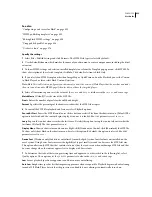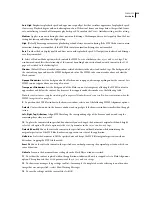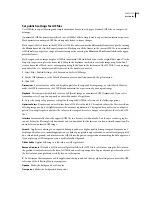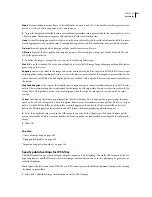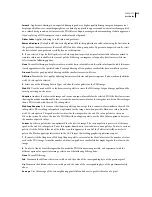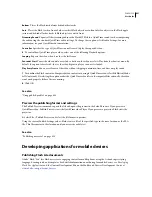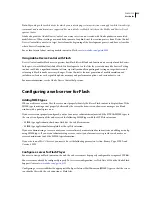
FLASH CS3
User Guide
417
Typical paths to the First Run folder are as follows:
•
In Windows XP or Vista, browse to
boot drive
\Program Files\Adobe\Adobe Flash CS3\
language
\First Run\.
•
On the Macintosh, browse to
Macintosh HD
/Applications/Adobe Flash CS3/First Run/.
User-level configuration folder
Found in the user profile area, this folder is always writable by the current user. Typical paths to this folder are as
follows:
•
In Windows XP or Vista, browse to
boot drive
\Documents and Settings\
username
\Local Settings\Application
Data\Adobe\Flash CS3\
language
\Configuration.
•
On the Macintosh, browse to
Macintosh HD
/Users/
username
/Library/Application Support/Adobe/Flash
CS3/
language
/Configuration/.
Note:
Flash for Windows uses the Local Settings folder for the user-level configuration files. This use differs from Flash
MX and the rest of the Studio MX family (including Dreamweaver MX 2004), which all use the Roaming Profile config-
uration folder for user-level configuration files. Roaming profiles allow network users to automatically store their config-
uration settings on a network server, and then move to different workstations on the network and always have an
application load the same configuration files. The Local Settings folder differs from the Roaming Profile folder in that
when the network is set up, files in Local Settings are not saved to a server to support roaming profiles.
All-user-level configuration folder
Found in the common user profile area, this folder is part of the standard Windows and Macintosh operating system
installations and is shared by all users of a particular computer. The operating system makes available to all users of
the computer any files placed in this folder. Typical paths to this folder are as follows:
•
In Windows XP or Vista, browse to
boot drive
\Documents and Settings\All Users\Application Data\Adobe\Flash
CS3\
language
\Configuration\.
•
On the Macintosh, browse to
Macintosh HD
/Users/Shared/Application Support/Adobe/Flash
CS3/
language
/Configuration/.
Restricted Users configuration folder
For users with restricted privileges on a workstation, typically, in a networked environment, only system adminis-
trators have administrative access to workstations. All other users are given restricted access, which usually means
that these users can’t write to application-level files (such as the Program Files directory in Windows or the Applica-
tions folder in Macintosh OS X).





















